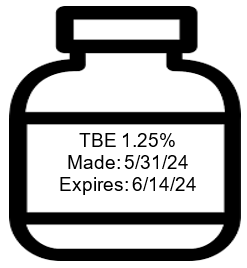IG033: Tribromoethanol (Avertin®) in Rodents
IACUC Guideline Number: IG033, Approved By: IACUC, Approval Date: 7/11/2024, Version: 3
Tribromoethanol (TBE) is an injectable anesthetic agent that was once manufactured as a pharmaceutical grade drug under various trade names, such as Avertin®. The use of TBE is generally discouraged, as several safer, readily available, and pharmaceutical-grade alternatives [i.e., isoflurane] have been shown to be highly effective with fewer potential side-effects. >NOTE: The use of non-pharmaceutical grade drugs must be scientifically justified in the Animal Use Protocol and approved by the IACUC prior to use.
Risks of TBE use in animals include degradation in the presence of heat or light to produce potentially irritating and toxic byproducts, irritation at high doses and concentrations or with repeated use (e.g., adhesions following IP injection), intestinal ileus, and reported morbidity and mortality even at doses within the recommended range.
TBE is appropriate only for short-term procedures in mice and rats, where it will be given only on a single occasion or in acute terminal procedures; all use of TBE must be scientifically justified and approved by the IACUC.
Dosing:
Because TBE is no longer available in pharmaceutical grade, investigators that wish to use this anesthetic have to compound their own solutions using non‐pharmaceutical grade reagents.
The dose in mice should be within the range of 125-300 mg/kg. At the low end of this range, and when used for rat anesthesia, it is recommended to combine TBE with a second anesthetic drug for more reliable plane of anesthesia.
Instructions for Compounding TBE:
Ingredients
- 2,2,2 tribromoethanol (TBE)
- 2‐methyl‐2‐butanol (amylene hydrate or tertiary amyl alcohol)
- Distilled water at a neutral pH
Directions for 1.25% TBE
- Dissolve 2.5 g TBE in 5 ml of 2‐methyl‐2‐ This requires heating to approximately 40°C (104°F) and vigorous stirring.
- Add distilled water, stirring continuously, up to a final volume of 200 ml.
- Filter sterilize through a 0.2 micron filter (e.g. Millipore® filter).
- Aliquot the final solution into appropriate, sterile containers, such as unused red‐cap blood collection tubes or sterile conical centrifuge tubes.
- Label and date the freshly prepared TBE solution with the date of preparation.
- As prepared above, the concentration of the solution is 5 mg/ml tribromoethanol.
NOTE: More concentrated solutions should not be used as the material is irritating and can cause peritonitis and death at higher concentrations.
Alternative Compounding Options
- 100% stock solution
- Prepare by mixing 10 g of 2,2,2-tribromoethyl alcohol with 10 ml of tertiary amyl alcohol.
- Fully dissolve by heating to 50°C, using a microwave oven, or a magnetic stirrer overnight. (Note: If 2,2,2-tribromoethanol is dark in color, it should be recrystallized before use.)
- Store at 4°C in a dark container protected from light.
- To use, dilute 100% stock to 1.25%, v/v, in distilled water, stirring vigorously until it is dissolved. Filter-sterilize through 0.2-micron filter (filtering also removes remaining undissolved crystals).
- Frozen concentrated stock solutions stored at minus (‐) 20°C:
- Dissolve 3.0 g TBE in 5 ml 2‐m‐2‐b and dilute to 100 ml with distilled water and aliquot to appropriate volumes. Label aliquots as instructed above with the date of preparation.
- Store at ‐20°C in appropriate, sterile containers.
- On day of procedure, thaw and dilute to 12.5 mg/ml with PBS.
- Discard any remaining thawed TBE solution on the same day of use, do not refreeze.
Storage
- Diluted, working solution TBE is to be stored at 4°C (39°F) and protected from light to prevent degradation. Even if refrigerated and wrapped in foil, the material will degrade over time.
- Therefore, TBE solution is to be made fresh at least every 2 weeks and old solution discarded in order to avoid administering harmful, degraded anesthetic products to animals.
- Please be sure to label the bottle from start date of preparation.
 Summary of Compound Expiration Dates:
Summary of Compound Expiration Dates:
- Up to 5 years: 2,2,2-Tribromoethanol powder (may vary based on manufacturer)
- 6 months from date of preparation: TBE stock solution
- 2 weeks from date of preparation: 25% TBE working solution
Proper Disposal of Expired Drugs:
Discard the TBE if the pH is < 5 (from degradation), is unusually discolored (typically yellow), or forms a precipitate out of solution
Whether hazardous or non-hazardous, all expired or unwanted drugs are to be disposed of properly according to MSU Environmental Health & Safety (EHS) guidelines. Guidance for specific types of waste can be found at MSU Environmental Health & Safety - Waste <https://ehs.msu.edu/waste/index.html>. For additional questions, please contact EHS at 517-355-0153 (or ehs@msu.edu )
References
- Lieggi CC, et. al. “Efficacy and safety of stored and newly prepared tribromoethanol in ICR mice.” Contemp Top Lab Anim Sci. 2005 44(1):17-22.
- Lieggi CC, et. al. “An evaluation of preparation methods and storage conditions of tribromoethanol.” Contemp Top Lab Anim Sci. 2005 44(1):11-16.
- Meyer RE, et. al. “A review of tribromoethanol anesthesia for production of genetically engineered mice and rats.” Lab Anim (NY). 2005 34(10):47-52.
- Papaioannou VE, et. al. “Efficacy of tribromoethanol anesthesia in mice.” Lab Anim Sci. 1993 43(2):189-92.
- Dyson M et. al. Anesthesia and Analgesia in Laboratory Animals, 2023.

